Effectiveness of Face Masks in Preventing Airborne Illnesses
VerifiedAdded on 2023/01/05
|8
|2178
|76
AI Summary
This assessment discusses the study of how wearing face masks is effective for preventing human to human transmission of airborne illnesses, with implications for reducing the spread of Covid-19. It explores public health recommendations, identifies gaps in evidence, and highlights further opportunities.
Contribute Materials
Your contribution can guide someone’s learning journey. Share your
documents today.
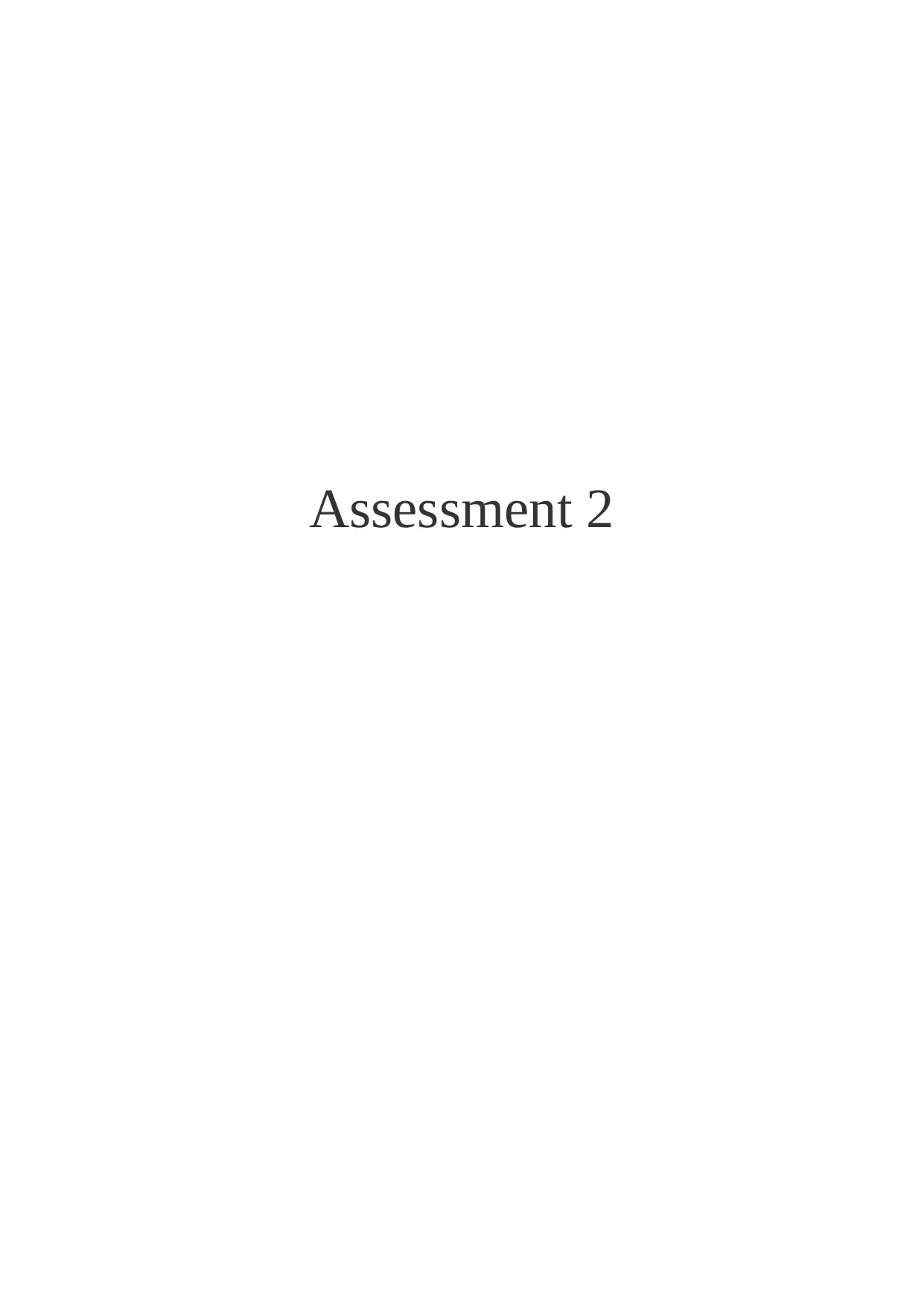
Assessment 2
Secure Best Marks with AI Grader
Need help grading? Try our AI Grader for instant feedback on your assignments.
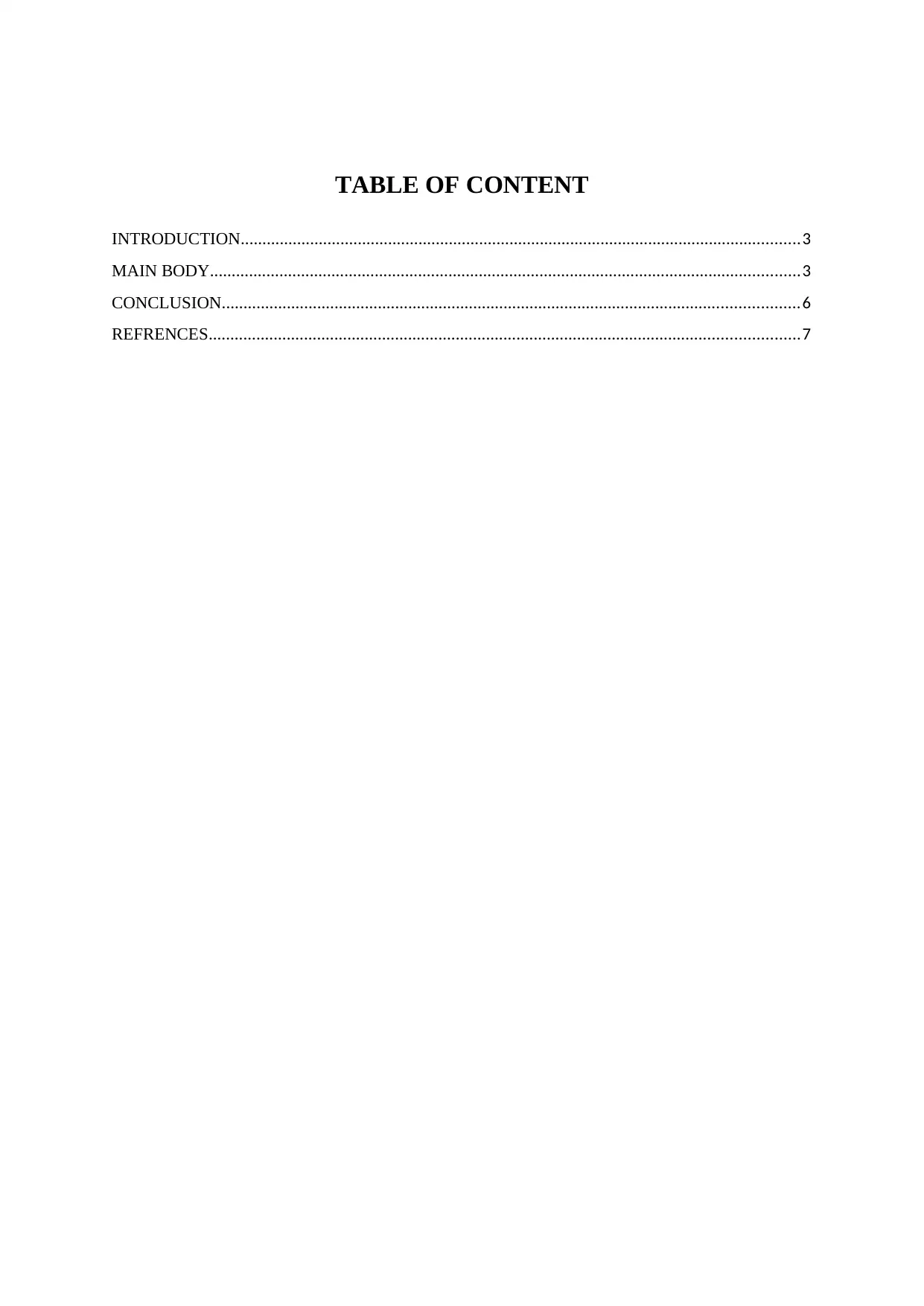
TABLE OF CONTENT
INTRODUCTION.................................................................................................................................3
MAIN BODY........................................................................................................................................3
CONCLUSION.....................................................................................................................................6
REFRENCES........................................................................................................................................7
INTRODUCTION.................................................................................................................................3
MAIN BODY........................................................................................................................................3
CONCLUSION.....................................................................................................................................6
REFRENCES........................................................................................................................................7
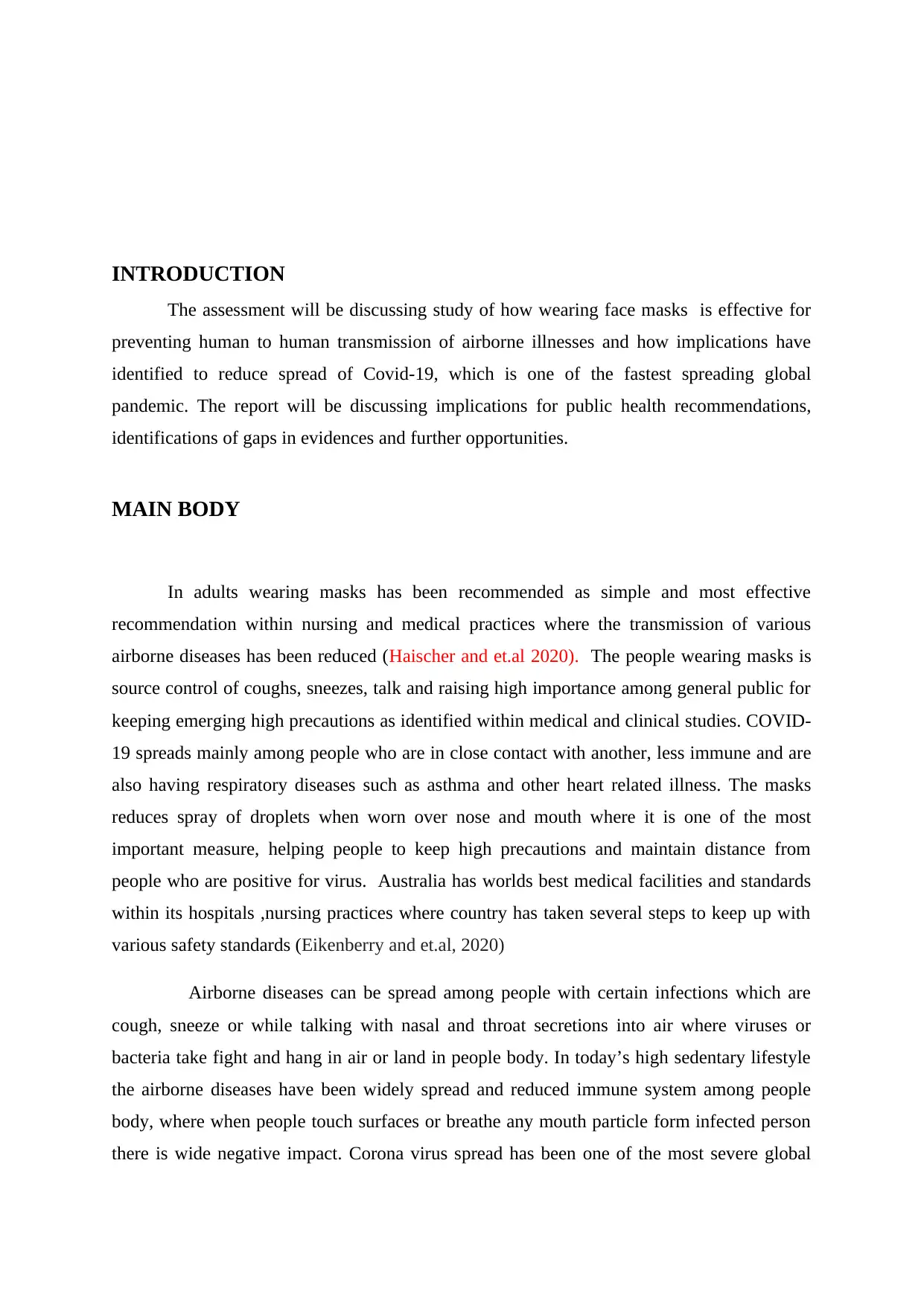
INTRODUCTION
The assessment will be discussing study of how wearing face masks is effective for
preventing human to human transmission of airborne illnesses and how implications have
identified to reduce spread of Covid-19, which is one of the fastest spreading global
pandemic. The report will be discussing implications for public health recommendations,
identifications of gaps in evidences and further opportunities.
MAIN BODY
In adults wearing masks has been recommended as simple and most effective
recommendation within nursing and medical practices where the transmission of various
airborne diseases has been reduced (Haischer and et.al 2020). The people wearing masks is
source control of coughs, sneezes, talk and raising high importance among general public for
keeping emerging high precautions as identified within medical and clinical studies. COVID-
19 spreads mainly among people who are in close contact with another, less immune and are
also having respiratory diseases such as asthma and other heart related illness. The masks
reduces spray of droplets when worn over nose and mouth where it is one of the most
important measure, helping people to keep high precautions and maintain distance from
people who are positive for virus. Australia has worlds best medical facilities and standards
within its hospitals ,nursing practices where country has taken several steps to keep up with
various safety standards (Eikenberry and et.al, 2020)
Airborne diseases can be spread among people with certain infections which are
cough, sneeze or while talking with nasal and throat secretions into air where viruses or
bacteria take fight and hang in air or land in people body. In today’s high sedentary lifestyle
the airborne diseases have been widely spread and reduced immune system among people
body, where when people touch surfaces or breathe any mouth particle form infected person
there is wide negative impact. Corona virus spread has been one of the most severe global
The assessment will be discussing study of how wearing face masks is effective for
preventing human to human transmission of airborne illnesses and how implications have
identified to reduce spread of Covid-19, which is one of the fastest spreading global
pandemic. The report will be discussing implications for public health recommendations,
identifications of gaps in evidences and further opportunities.
MAIN BODY
In adults wearing masks has been recommended as simple and most effective
recommendation within nursing and medical practices where the transmission of various
airborne diseases has been reduced (Haischer and et.al 2020). The people wearing masks is
source control of coughs, sneezes, talk and raising high importance among general public for
keeping emerging high precautions as identified within medical and clinical studies. COVID-
19 spreads mainly among people who are in close contact with another, less immune and are
also having respiratory diseases such as asthma and other heart related illness. The masks
reduces spray of droplets when worn over nose and mouth where it is one of the most
important measure, helping people to keep high precautions and maintain distance from
people who are positive for virus. Australia has worlds best medical facilities and standards
within its hospitals ,nursing practices where country has taken several steps to keep up with
various safety standards (Eikenberry and et.al, 2020)
Airborne diseases can be spread among people with certain infections which are
cough, sneeze or while talking with nasal and throat secretions into air where viruses or
bacteria take fight and hang in air or land in people body. In today’s high sedentary lifestyle
the airborne diseases have been widely spread and reduced immune system among people
body, where when people touch surfaces or breathe any mouth particle form infected person
there is wide negative impact. Corona virus spread has been one of the most severe global
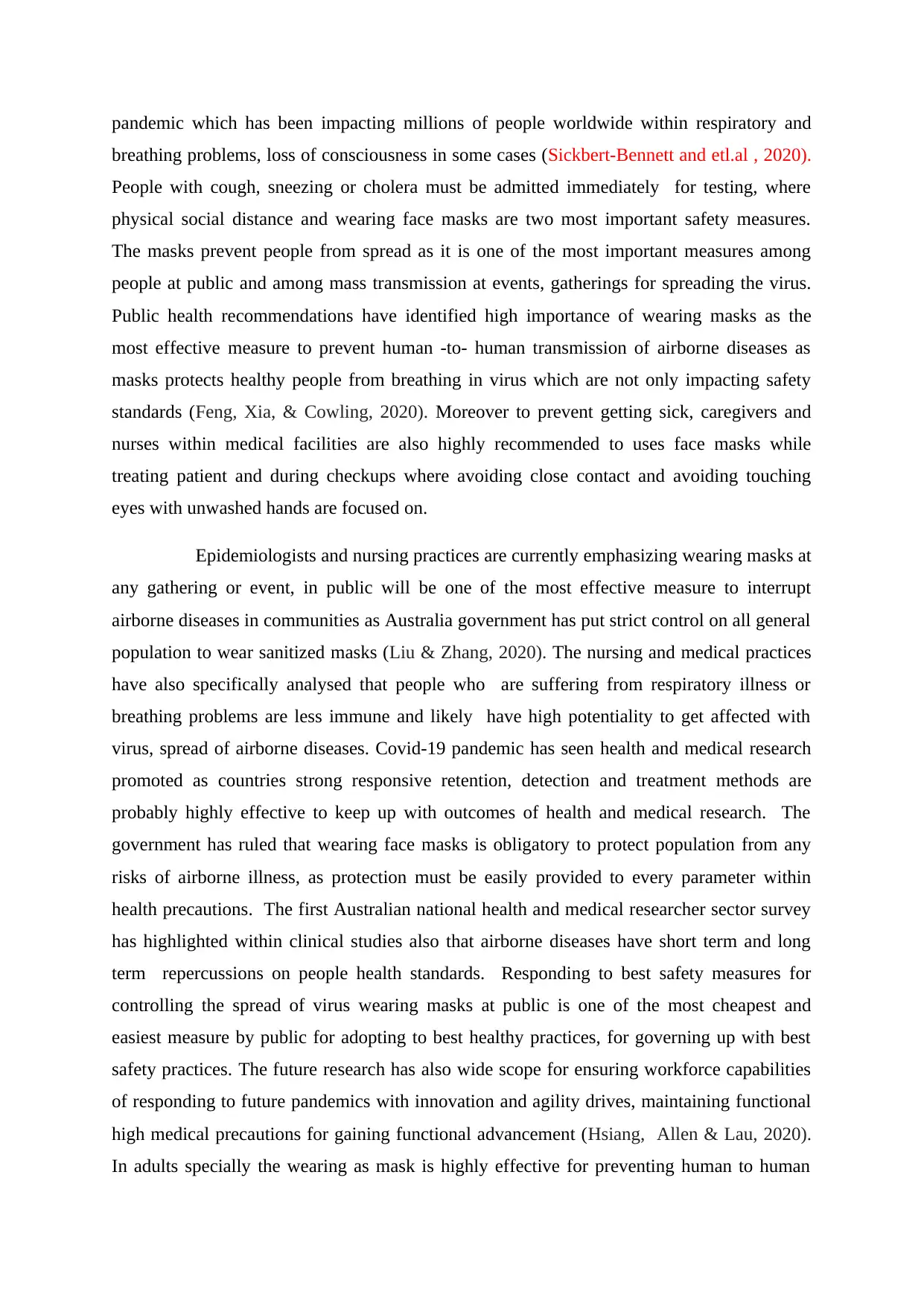
pandemic which has been impacting millions of people worldwide within respiratory and
breathing problems, loss of consciousness in some cases (Sickbert-Bennett and etl.al , 2020).
People with cough, sneezing or cholera must be admitted immediately for testing, where
physical social distance and wearing face masks are two most important safety measures.
The masks prevent people from spread as it is one of the most important measures among
people at public and among mass transmission at events, gatherings for spreading the virus.
Public health recommendations have identified high importance of wearing masks as the
most effective measure to prevent human -to- human transmission of airborne diseases as
masks protects healthy people from breathing in virus which are not only impacting safety
standards (Feng, Xia, & Cowling, 2020). Moreover to prevent getting sick, caregivers and
nurses within medical facilities are also highly recommended to uses face masks while
treating patient and during checkups where avoiding close contact and avoiding touching
eyes with unwashed hands are focused on.
Epidemiologists and nursing practices are currently emphasizing wearing masks at
any gathering or event, in public will be one of the most effective measure to interrupt
airborne diseases in communities as Australia government has put strict control on all general
population to wear sanitized masks (Liu & Zhang, 2020). The nursing and medical practices
have also specifically analysed that people who are suffering from respiratory illness or
breathing problems are less immune and likely have high potentiality to get affected with
virus, spread of airborne diseases. Covid-19 pandemic has seen health and medical research
promoted as countries strong responsive retention, detection and treatment methods are
probably highly effective to keep up with outcomes of health and medical research. The
government has ruled that wearing face masks is obligatory to protect population from any
risks of airborne illness, as protection must be easily provided to every parameter within
health precautions. The first Australian national health and medical researcher sector survey
has highlighted within clinical studies also that airborne diseases have short term and long
term repercussions on people health standards. Responding to best safety measures for
controlling the spread of virus wearing masks at public is one of the most cheapest and
easiest measure by public for adopting to best healthy practices, for governing up with best
safety practices. The future research has also wide scope for ensuring workforce capabilities
of responding to future pandemics with innovation and agility drives, maintaining functional
high medical precautions for gaining functional advancement (Hsiang, Allen & Lau, 2020).
In adults specially the wearing as mask is highly effective for preventing human to human
breathing problems, loss of consciousness in some cases (Sickbert-Bennett and etl.al , 2020).
People with cough, sneezing or cholera must be admitted immediately for testing, where
physical social distance and wearing face masks are two most important safety measures.
The masks prevent people from spread as it is one of the most important measures among
people at public and among mass transmission at events, gatherings for spreading the virus.
Public health recommendations have identified high importance of wearing masks as the
most effective measure to prevent human -to- human transmission of airborne diseases as
masks protects healthy people from breathing in virus which are not only impacting safety
standards (Feng, Xia, & Cowling, 2020). Moreover to prevent getting sick, caregivers and
nurses within medical facilities are also highly recommended to uses face masks while
treating patient and during checkups where avoiding close contact and avoiding touching
eyes with unwashed hands are focused on.
Epidemiologists and nursing practices are currently emphasizing wearing masks at
any gathering or event, in public will be one of the most effective measure to interrupt
airborne diseases in communities as Australia government has put strict control on all general
population to wear sanitized masks (Liu & Zhang, 2020). The nursing and medical practices
have also specifically analysed that people who are suffering from respiratory illness or
breathing problems are less immune and likely have high potentiality to get affected with
virus, spread of airborne diseases. Covid-19 pandemic has seen health and medical research
promoted as countries strong responsive retention, detection and treatment methods are
probably highly effective to keep up with outcomes of health and medical research. The
government has ruled that wearing face masks is obligatory to protect population from any
risks of airborne illness, as protection must be easily provided to every parameter within
health precautions. The first Australian national health and medical researcher sector survey
has highlighted within clinical studies also that airborne diseases have short term and long
term repercussions on people health standards. Responding to best safety measures for
controlling the spread of virus wearing masks at public is one of the most cheapest and
easiest measure by public for adopting to best healthy practices, for governing up with best
safety practices. The future research has also wide scope for ensuring workforce capabilities
of responding to future pandemics with innovation and agility drives, maintaining functional
high medical precautions for gaining functional advancement (Hsiang, Allen & Lau, 2020).
In adults specially the wearing as mask is highly effective for preventing human to human
Secure Best Marks with AI Grader
Need help grading? Try our AI Grader for instant feedback on your assignments.
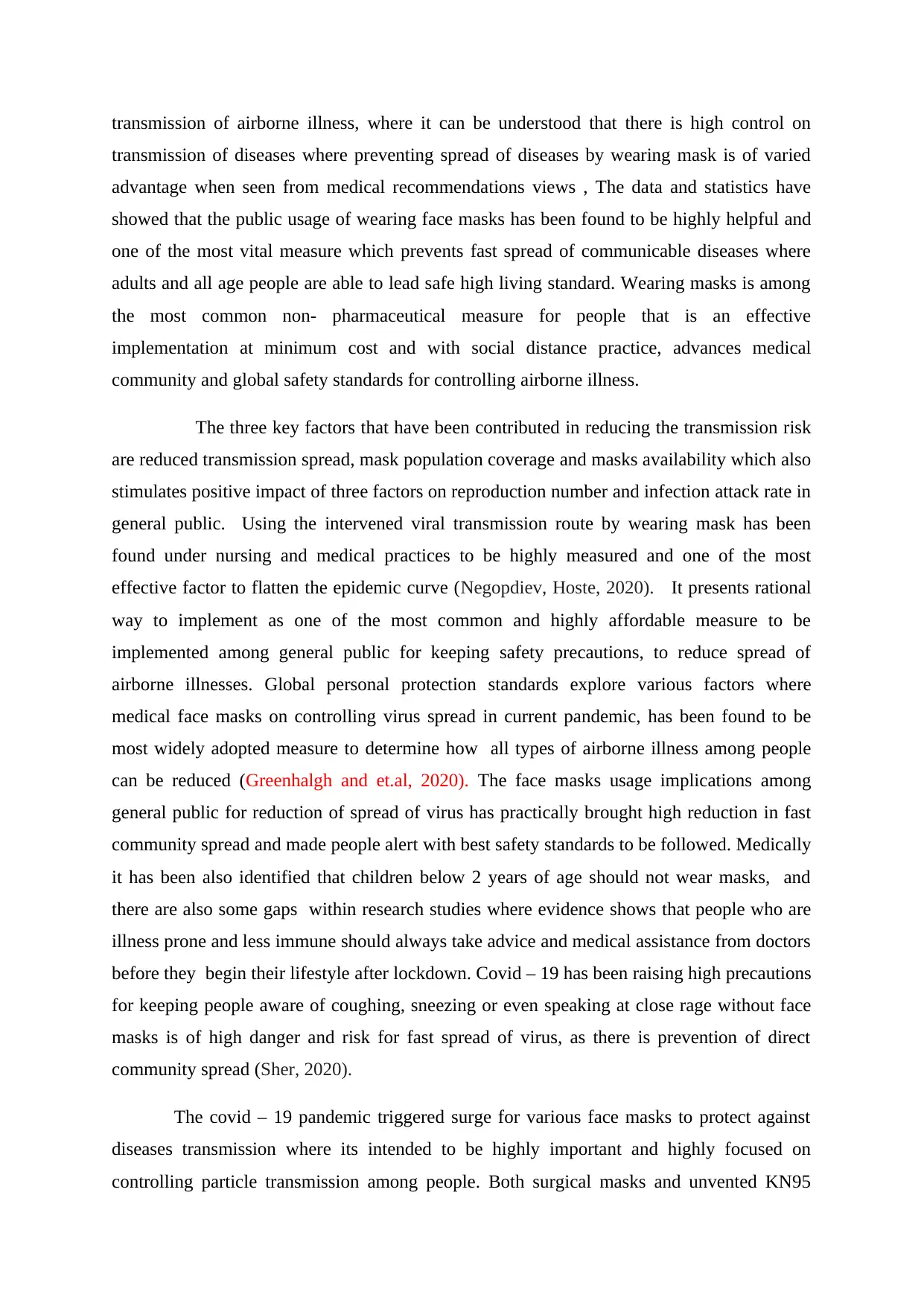
transmission of airborne illness, where it can be understood that there is high control on
transmission of diseases where preventing spread of diseases by wearing mask is of varied
advantage when seen from medical recommendations views , The data and statistics have
showed that the public usage of wearing face masks has been found to be highly helpful and
one of the most vital measure which prevents fast spread of communicable diseases where
adults and all age people are able to lead safe high living standard. Wearing masks is among
the most common non- pharmaceutical measure for people that is an effective
implementation at minimum cost and with social distance practice, advances medical
community and global safety standards for controlling airborne illness.
The three key factors that have been contributed in reducing the transmission risk
are reduced transmission spread, mask population coverage and masks availability which also
stimulates positive impact of three factors on reproduction number and infection attack rate in
general public. Using the intervened viral transmission route by wearing mask has been
found under nursing and medical practices to be highly measured and one of the most
effective factor to flatten the epidemic curve (Negopdiev, Hoste, 2020). It presents rational
way to implement as one of the most common and highly affordable measure to be
implemented among general public for keeping safety precautions, to reduce spread of
airborne illnesses. Global personal protection standards explore various factors where
medical face masks on controlling virus spread in current pandemic, has been found to be
most widely adopted measure to determine how all types of airborne illness among people
can be reduced (Greenhalgh and et.al, 2020). The face masks usage implications among
general public for reduction of spread of virus has practically brought high reduction in fast
community spread and made people alert with best safety standards to be followed. Medically
it has been also identified that children below 2 years of age should not wear masks, and
there are also some gaps within research studies where evidence shows that people who are
illness prone and less immune should always take advice and medical assistance from doctors
before they begin their lifestyle after lockdown. Covid – 19 has been raising high precautions
for keeping people aware of coughing, sneezing or even speaking at close rage without face
masks is of high danger and risk for fast spread of virus, as there is prevention of direct
community spread (Sher, 2020).
The covid – 19 pandemic triggered surge for various face masks to protect against
diseases transmission where its intended to be highly important and highly focused on
controlling particle transmission among people. Both surgical masks and unvented KN95
transmission of diseases where preventing spread of diseases by wearing mask is of varied
advantage when seen from medical recommendations views , The data and statistics have
showed that the public usage of wearing face masks has been found to be highly helpful and
one of the most vital measure which prevents fast spread of communicable diseases where
adults and all age people are able to lead safe high living standard. Wearing masks is among
the most common non- pharmaceutical measure for people that is an effective
implementation at minimum cost and with social distance practice, advances medical
community and global safety standards for controlling airborne illness.
The three key factors that have been contributed in reducing the transmission risk
are reduced transmission spread, mask population coverage and masks availability which also
stimulates positive impact of three factors on reproduction number and infection attack rate in
general public. Using the intervened viral transmission route by wearing mask has been
found under nursing and medical practices to be highly measured and one of the most
effective factor to flatten the epidemic curve (Negopdiev, Hoste, 2020). It presents rational
way to implement as one of the most common and highly affordable measure to be
implemented among general public for keeping safety precautions, to reduce spread of
airborne illnesses. Global personal protection standards explore various factors where
medical face masks on controlling virus spread in current pandemic, has been found to be
most widely adopted measure to determine how all types of airborne illness among people
can be reduced (Greenhalgh and et.al, 2020). The face masks usage implications among
general public for reduction of spread of virus has practically brought high reduction in fast
community spread and made people alert with best safety standards to be followed. Medically
it has been also identified that children below 2 years of age should not wear masks, and
there are also some gaps within research studies where evidence shows that people who are
illness prone and less immune should always take advice and medical assistance from doctors
before they begin their lifestyle after lockdown. Covid – 19 has been raising high precautions
for keeping people aware of coughing, sneezing or even speaking at close rage without face
masks is of high danger and risk for fast spread of virus, as there is prevention of direct
community spread (Sher, 2020).
The covid – 19 pandemic triggered surge for various face masks to protect against
diseases transmission where its intended to be highly important and highly focused on
controlling particle transmission among people. Both surgical masks and unvented KN95
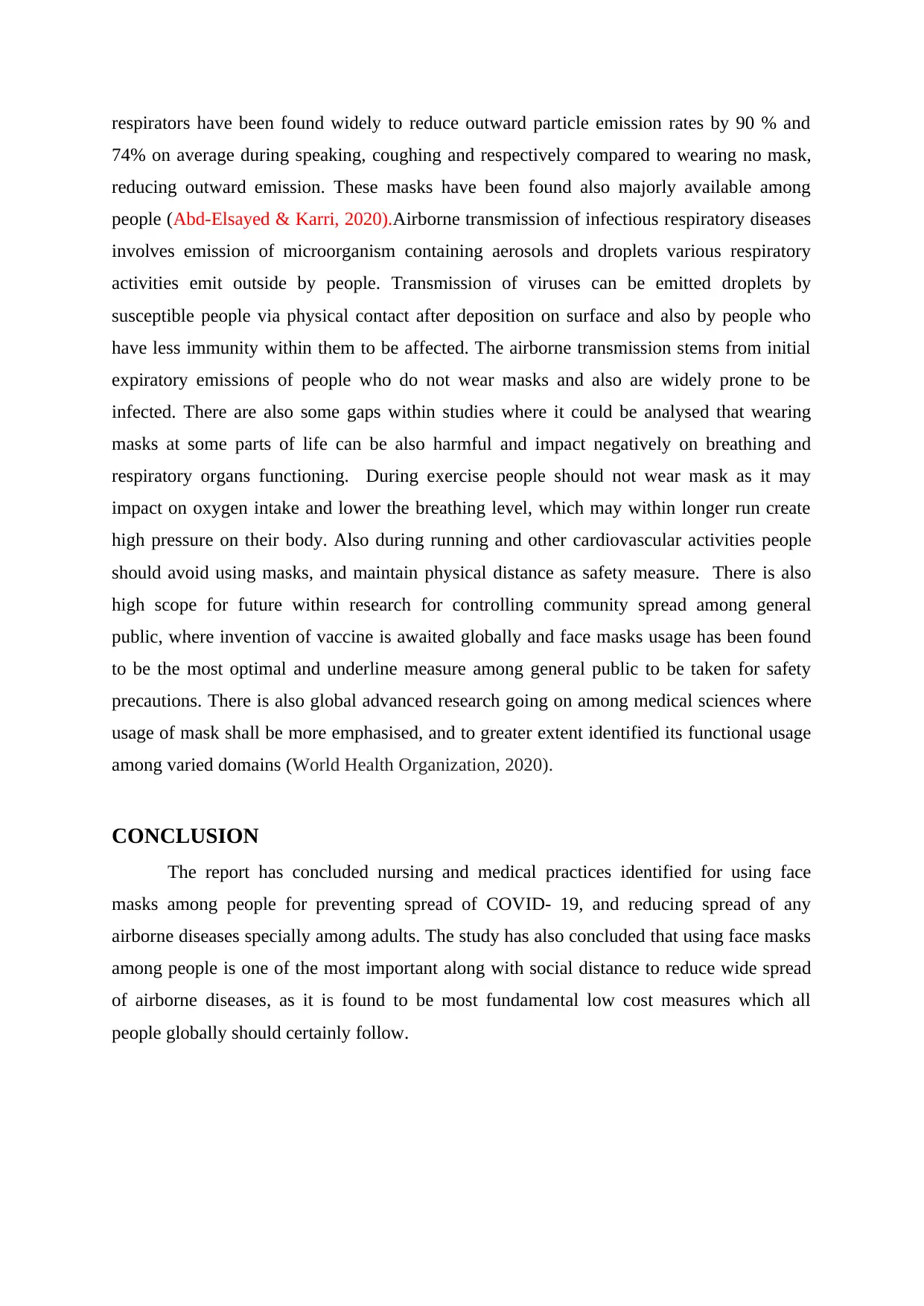
respirators have been found widely to reduce outward particle emission rates by 90 % and
74% on average during speaking, coughing and respectively compared to wearing no mask,
reducing outward emission. These masks have been found also majorly available among
people (Abd-Elsayed & Karri, 2020).Airborne transmission of infectious respiratory diseases
involves emission of microorganism containing aerosols and droplets various respiratory
activities emit outside by people. Transmission of viruses can be emitted droplets by
susceptible people via physical contact after deposition on surface and also by people who
have less immunity within them to be affected. The airborne transmission stems from initial
expiratory emissions of people who do not wear masks and also are widely prone to be
infected. There are also some gaps within studies where it could be analysed that wearing
masks at some parts of life can be also harmful and impact negatively on breathing and
respiratory organs functioning. During exercise people should not wear mask as it may
impact on oxygen intake and lower the breathing level, which may within longer run create
high pressure on their body. Also during running and other cardiovascular activities people
should avoid using masks, and maintain physical distance as safety measure. There is also
high scope for future within research for controlling community spread among general
public, where invention of vaccine is awaited globally and face masks usage has been found
to be the most optimal and underline measure among general public to be taken for safety
precautions. There is also global advanced research going on among medical sciences where
usage of mask shall be more emphasised, and to greater extent identified its functional usage
among varied domains (World Health Organization, 2020).
CONCLUSION
The report has concluded nursing and medical practices identified for using face
masks among people for preventing spread of COVID- 19, and reducing spread of any
airborne diseases specially among adults. The study has also concluded that using face masks
among people is one of the most important along with social distance to reduce wide spread
of airborne diseases, as it is found to be most fundamental low cost measures which all
people globally should certainly follow.
74% on average during speaking, coughing and respectively compared to wearing no mask,
reducing outward emission. These masks have been found also majorly available among
people (Abd-Elsayed & Karri, 2020).Airborne transmission of infectious respiratory diseases
involves emission of microorganism containing aerosols and droplets various respiratory
activities emit outside by people. Transmission of viruses can be emitted droplets by
susceptible people via physical contact after deposition on surface and also by people who
have less immunity within them to be affected. The airborne transmission stems from initial
expiratory emissions of people who do not wear masks and also are widely prone to be
infected. There are also some gaps within studies where it could be analysed that wearing
masks at some parts of life can be also harmful and impact negatively on breathing and
respiratory organs functioning. During exercise people should not wear mask as it may
impact on oxygen intake and lower the breathing level, which may within longer run create
high pressure on their body. Also during running and other cardiovascular activities people
should avoid using masks, and maintain physical distance as safety measure. There is also
high scope for future within research for controlling community spread among general
public, where invention of vaccine is awaited globally and face masks usage has been found
to be the most optimal and underline measure among general public to be taken for safety
precautions. There is also global advanced research going on among medical sciences where
usage of mask shall be more emphasised, and to greater extent identified its functional usage
among varied domains (World Health Organization, 2020).
CONCLUSION
The report has concluded nursing and medical practices identified for using face
masks among people for preventing spread of COVID- 19, and reducing spread of any
airborne diseases specially among adults. The study has also concluded that using face masks
among people is one of the most important along with social distance to reduce wide spread
of airborne diseases, as it is found to be most fundamental low cost measures which all
people globally should certainly follow.
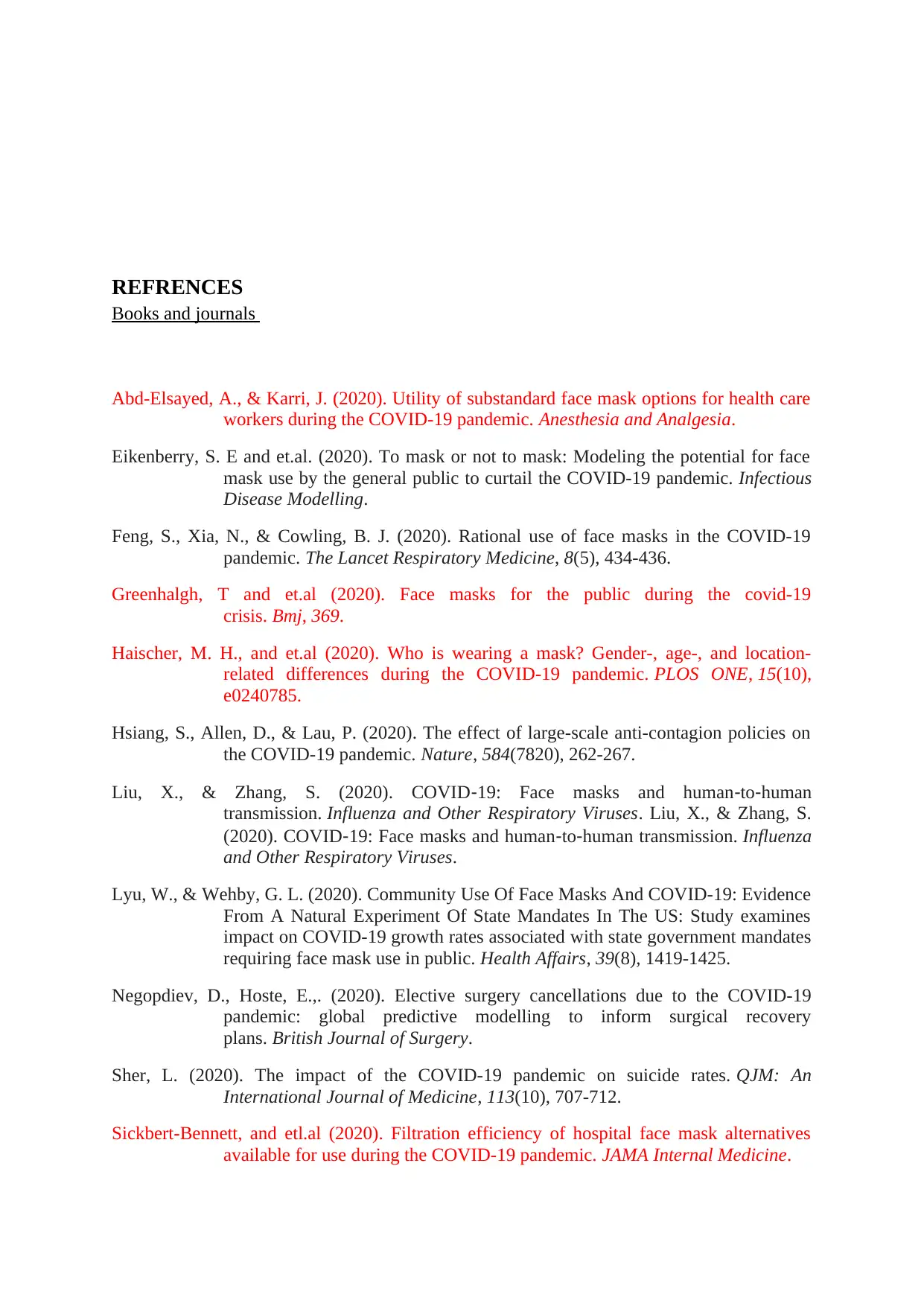
REFRENCES
Books and journals
Abd-Elsayed, A., & Karri, J. (2020). Utility of substandard face mask options for health care
workers during the COVID-19 pandemic. Anesthesia and Analgesia.
Eikenberry, S. E and et.al. (2020). To mask or not to mask: Modeling the potential for face
mask use by the general public to curtail the COVID-19 pandemic. Infectious
Disease Modelling.
Feng, S., Xia, N., & Cowling, B. J. (2020). Rational use of face masks in the COVID-19
pandemic. The Lancet Respiratory Medicine, 8(5), 434-436.
Greenhalgh, T and et.al (2020). Face masks for the public during the covid-19
crisis. Bmj, 369.
Haischer, M. H., and et.al (2020). Who is wearing a mask? Gender-, age-, and location-
related differences during the COVID-19 pandemic. PLOS ONE, 15(10),
e0240785.
Hsiang, S., Allen, D., & Lau, P. (2020). The effect of large-scale anti-contagion policies on
the COVID-19 pandemic. Nature, 584(7820), 262-267.
Liu, X., & Zhang, S. (2020). COVID‐19: Face masks and human‐to‐human
transmission. Influenza and Other Respiratory Viruses. Liu, X., & Zhang, S.
(2020). COVID‐19: Face masks and human‐to‐human transmission. Influenza
and Other Respiratory Viruses.
Lyu, W., & Wehby, G. L. (2020). Community Use Of Face Masks And COVID-19: Evidence
From A Natural Experiment Of State Mandates In The US: Study examines
impact on COVID-19 growth rates associated with state government mandates
requiring face mask use in public. Health Affairs, 39(8), 1419-1425.
Negopdiev, D., Hoste, E.,. (2020). Elective surgery cancellations due to the COVID-19
pandemic: global predictive modelling to inform surgical recovery
plans. British Journal of Surgery.
Sher, L. (2020). The impact of the COVID-19 pandemic on suicide rates. QJM: An
International Journal of Medicine, 113(10), 707-712.
Sickbert-Bennett, and etl.al (2020). Filtration efficiency of hospital face mask alternatives
available for use during the COVID-19 pandemic. JAMA Internal Medicine.
Books and journals
Abd-Elsayed, A., & Karri, J. (2020). Utility of substandard face mask options for health care
workers during the COVID-19 pandemic. Anesthesia and Analgesia.
Eikenberry, S. E and et.al. (2020). To mask or not to mask: Modeling the potential for face
mask use by the general public to curtail the COVID-19 pandemic. Infectious
Disease Modelling.
Feng, S., Xia, N., & Cowling, B. J. (2020). Rational use of face masks in the COVID-19
pandemic. The Lancet Respiratory Medicine, 8(5), 434-436.
Greenhalgh, T and et.al (2020). Face masks for the public during the covid-19
crisis. Bmj, 369.
Haischer, M. H., and et.al (2020). Who is wearing a mask? Gender-, age-, and location-
related differences during the COVID-19 pandemic. PLOS ONE, 15(10),
e0240785.
Hsiang, S., Allen, D., & Lau, P. (2020). The effect of large-scale anti-contagion policies on
the COVID-19 pandemic. Nature, 584(7820), 262-267.
Liu, X., & Zhang, S. (2020). COVID‐19: Face masks and human‐to‐human
transmission. Influenza and Other Respiratory Viruses. Liu, X., & Zhang, S.
(2020). COVID‐19: Face masks and human‐to‐human transmission. Influenza
and Other Respiratory Viruses.
Lyu, W., & Wehby, G. L. (2020). Community Use Of Face Masks And COVID-19: Evidence
From A Natural Experiment Of State Mandates In The US: Study examines
impact on COVID-19 growth rates associated with state government mandates
requiring face mask use in public. Health Affairs, 39(8), 1419-1425.
Negopdiev, D., Hoste, E.,. (2020). Elective surgery cancellations due to the COVID-19
pandemic: global predictive modelling to inform surgical recovery
plans. British Journal of Surgery.
Sher, L. (2020). The impact of the COVID-19 pandemic on suicide rates. QJM: An
International Journal of Medicine, 113(10), 707-712.
Sickbert-Bennett, and etl.al (2020). Filtration efficiency of hospital face mask alternatives
available for use during the COVID-19 pandemic. JAMA Internal Medicine.
Paraphrase This Document
Need a fresh take? Get an instant paraphrase of this document with our AI Paraphraser
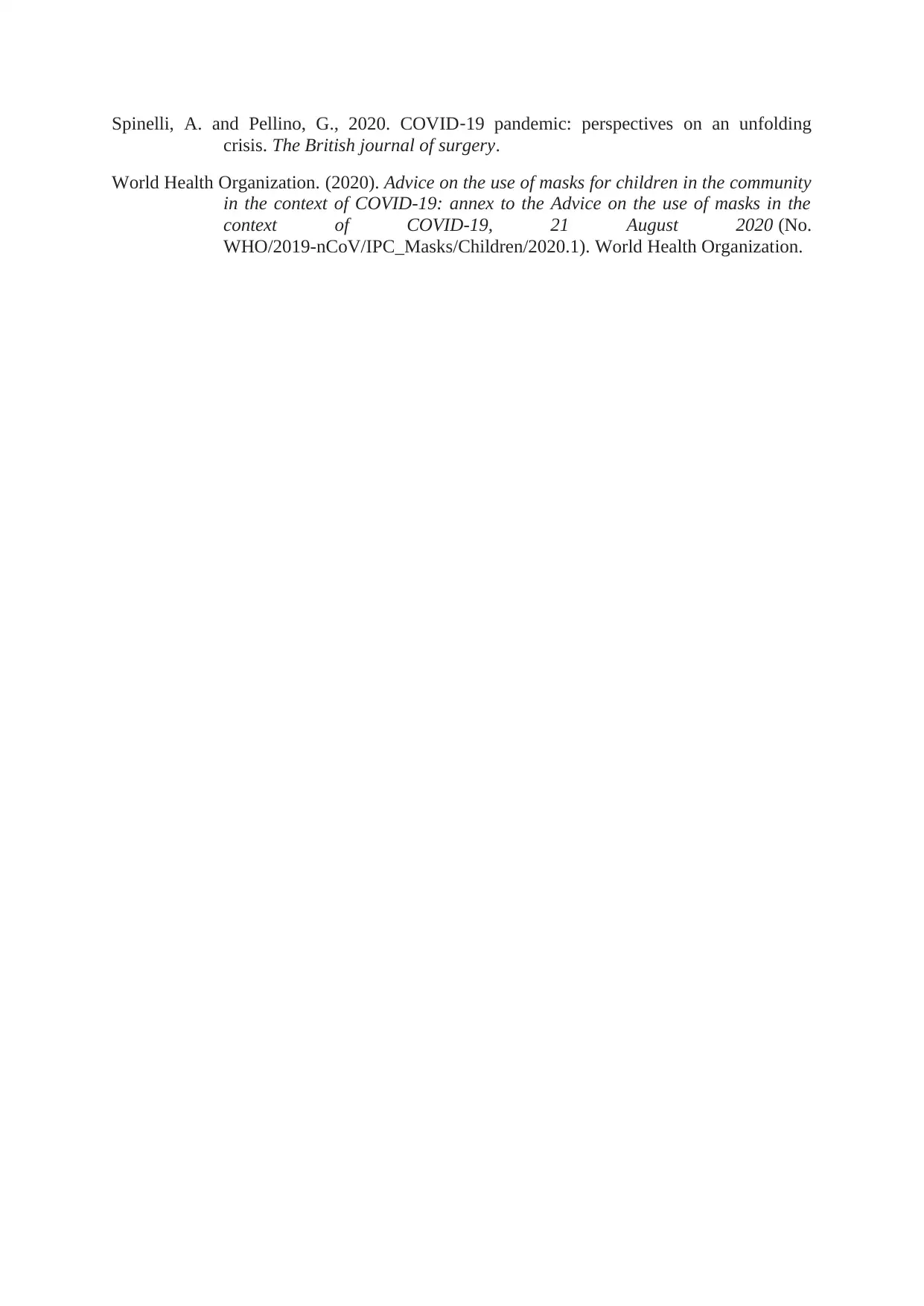
Spinelli, A. and Pellino, G., 2020. COVID‐19 pandemic: perspectives on an unfolding
crisis. The British journal of surgery.
World Health Organization. (2020). Advice on the use of masks for children in the community
in the context of COVID-19: annex to the Advice on the use of masks in the
context of COVID-19, 21 August 2020 (No.
WHO/2019-nCoV/IPC_Masks/Children/2020.1). World Health Organization.
crisis. The British journal of surgery.
World Health Organization. (2020). Advice on the use of masks for children in the community
in the context of COVID-19: annex to the Advice on the use of masks in the
context of COVID-19, 21 August 2020 (No.
WHO/2019-nCoV/IPC_Masks/Children/2020.1). World Health Organization.
1 out of 8
Related Documents
Your All-in-One AI-Powered Toolkit for Academic Success.
+13062052269
info@desklib.com
Available 24*7 on WhatsApp / Email
![[object Object]](/_next/static/media/star-bottom.7253800d.svg)
Unlock your academic potential
© 2024 | Zucol Services PVT LTD | All rights reserved.





